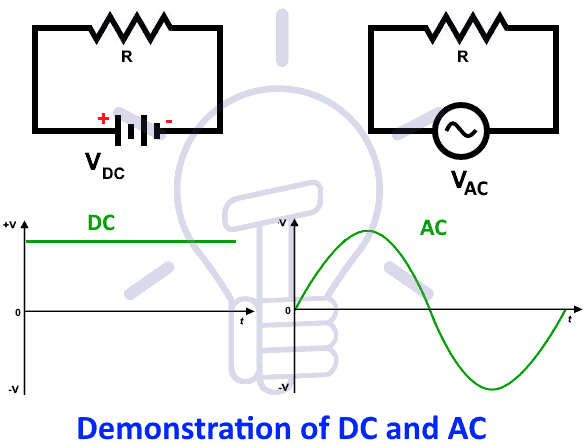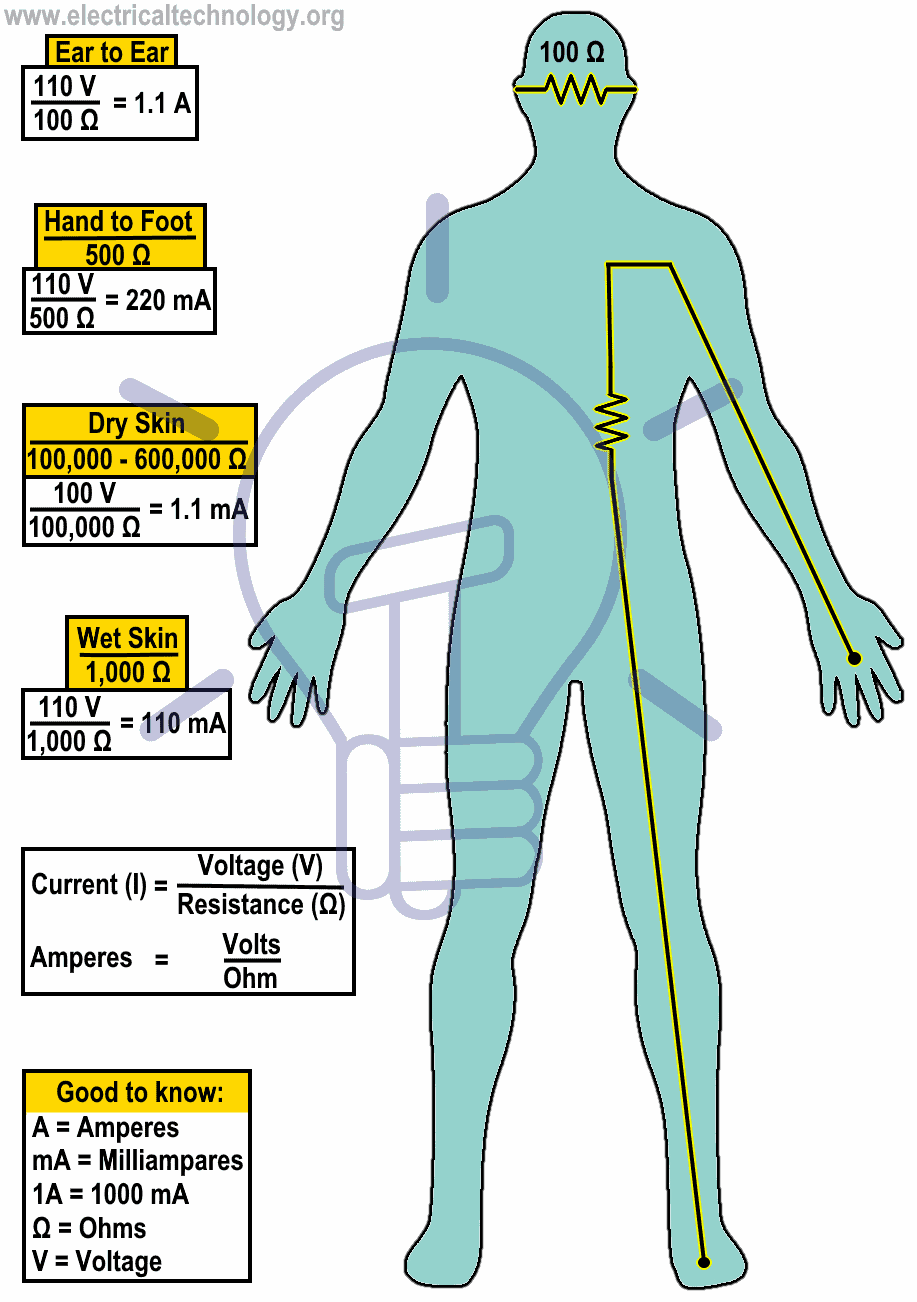AC or DC – Which One is More Dangerous And Why ?
Which is More Dangerous – AC or DC?
First of all, keep in mind that both AC and DC voltage and Current are dangerous and hazardous. Both are our friends and worst enemies as well as they won’t miss you if you give it a chance.

AC is more serial killer as AC with less frequency (50 Hz in EU and 60 Hz in US) is more dangerous than the DC having the same level of voltage. In other words, 230V AC (or 120V AC) is more dangerous than 230V DC or 120V DC respectively. But keep in mind that DC has the ability to roast you i.e. if we say AC is more dangerous, it doesn’t mean that DC will only play with you. Stay away and don’t trust both.
Related Posts:
- Which One Kills – Current or Voltage and Why? Amps vs Volts
- Which One is More Dangerous? 120V or 230V and Why?
- Which One is More Dangerous? 50Hz or 60Hz in 120V/230V?
AC voltage and current with low frequency i.e. 50 Hz or 60 Hz is more dangerous than AC with higher frequency (say 500 0r 600 Hz). Same is the case i.e. AC Currents and voltages are three to five times more dangerous than DC having the same level of voltage.
In case of DC voltage and currents, It causes a single convulsive contraction (a jerky and uncontrollable process in which muscles become shorter and tighter) which pushes the victim away from the DC current or voltage source they touched.
In case of AC voltage and currents, it causes tetany (a condition marked by intermittent muscular spasms) or extended muscle contraction which leads to freezing the victim (or part(s) of the body) touching the AC voltage or current source.
- Related Post: Why Do Electronic Circuits Use DC Current instead of AC?
Due to the alternating nature behavior of AC, it causes the heart’s pacemaker neurons into atrial fibrillation which is more dangerous than DC, where cardiac standstill (due to ventricular fibrillation) occurs in case of electric shock. In this case, there is a better chance for “frozen heart” to get back on the normal track as compared to fibrillating heart caused by AC. In those cases, defibrillating equipment (which supplies DC units to halt the fibrillation and bring back the heart to the normal condition) are used as emergency medical service.
Generally, the final decision depends on multiple factors like, human body resistance, wet or dry skin or place, thickness of the skin, weight, sex, age, level of current and voltages, frequency etc.
Related Post:
If we consider the minimum level of AC and DC voltages, 50V AC in Dry condition and 25V in humid and wet places and up to 120V DC are considered safe in case of direct or indirect contacts with electrical installations. The above statement and the following table shows that AC Current and Voltage are more dangerous than DC.
For example, In case of AC, the safest limit is 50V (or 25V in humidity) where in DC, the safe limit is 120V DC. Same is the case for current, i.e. lower currents are needed for the same effect on the human body compared to DC which is low. The following table shows the story of AC and DC and its effects on the human body.
Always Remember: Current Kills, Not the Voltage. But Voltage is necessary to drive the Current. I.e. Amperes are responsible for electrocution, Not the Volts.
| AC in mA (50Hz) | DC in mA | Effects |
| 0.5 – 1.5 | 0.4 | Perception |
| 1.3 | 4 – 15 | Surprise |
| 3 – 22 | 15 – 88 | Let’s Go (Reflex Action) |
| 22 – 40 | 80 – 160 | Muscular Inhibition |
| 40 – 100 | 160 – 300 | Respiratory Block |
| More than 100 | More than 300 | Usually Fatal |

Why AC is More Dangerous than DC?
Following are some reasons showing that AC is more dangerous than DC.
RMS and Peak Value
The domestic supply in our homes are 230V AC (in EU) and 120V AC in US. It is the effective or RMS Voltage. It means that alternating voltage available has the same heating effect as 230V DC or 120V AC respectively.
The equation of this alternating current is
V = Vm Sin ω t
Where
- Vm = √2 VRMS
- ω = 2πf … (f = 50 0r 60 Hz Frequency)
Putting the values and solving for Voltage:
230 x √2 Sin x 2 (3.1415) x 50Hz x t
230 x √2 Sin x 314 x t Volts.
Now the Peak Value of AC Voltage or Current, (this doesn’t apply on DC due to the alternating sinusoidal waves of AC).
VRMS = VPK ÷ √2 or VRMS = 0.707 x VPK
Similarly,
IRMS = IPK ÷ √2 or IRMS = 0.707 x IPK
Using the above formula, we find the value of AC Peak Voltage and Current as follow
VPK = √2 x VRMS and IPK = √2 x IRMS
To calculate the max or peak value of AC Voltage for our homes supply (where home supply is 230V or 120V AC)
VPK = 1.414 x 230V = 325V AC (or 170V Peak AC in case of 120V AC home supply).
The above calculation shows that our home supply voltage which is 230V AC or 120V AC are RMS voltages and the Peak voltages of these RMS voltages are 325V or 170V or 650 peak to peak or 320 peak to peak voltages.
Respectively, whereas DC has only RMS value which is contact i.e 230V DC or 120V DC.
In other words, for both AC and DC having the same level of Voltage, AC turns out to be about 325V or 170V i.e. it’s more than it appears and yes, the more voltage, the higher the chance of electrocution. In short, More DC voltage or current is needed to induce the same hazardous effect as AC voltage and current.
Related Post:
Capacitance
A victim body acts as an insulating medium between the live wire and ground leading to capacitance. But we know that a capacitor blocks DC while AC can pass through it. Let’s see mathematically,
- Frequency in DC = 0Hz
- Frequency in AC = 50 or 60 Hz.
Resistance in DC:
XC = 1 ÷ 2πfC in Ω
If we put “f = frequency” as zero, then the capacitive reactance (XC) would be infinite. That’s why the capacitor blocks DC to pass through it.
Now resistance in AC (also known as impedance)
Impedance Z = √ (R2 + XC2)
If we put frequency as 50 or 60Hz, the overall impedance (i.e. resistance) would decrease. This way, AC has the ability to easily pass through the capacitor. It means AC is more dangerous than DC in cases when the human body acts as a capacitor.
In short, the impedance and resistance in DC is lower than AC as it decreases when frequency increases. This way, AC is more harmful than DC.
Related Post: What Happens When an AC Line Touches a DC Line?
Frequency
Some having the concept that DC is more dangerous than AC with the same level of voltage because AC changes it direction multiple times (i.e. AC touches the zero value 50 or 60 times) per second due to frequency and there is a chance for the victim to skip the shock, whereas there is no frequency in DC.
Now if we consider the frequency as 60 or 50Hz, let’s see how fast AC changes its direction.
T = 1 ÷ f
T = 1 ÷ 50Hz = 0.02 Seconds.
It shows that AC touches the zero point after each 0.20 seconds, where the human brain is not that much faster (except the unintentional functions) to respond to electric shock and move back from the voltage source.
- Related Post: Difference between AC and DC Resistance
The 50 or 60Hz frequency plays an important role in the electric shock effect on the human body. For example, the low voltage about 25V AC with 60 Hz are harmful (wet and humid body).
Note: Both AC and DC voltages and currents are dangerous. Don’t touch the live wires. In case of electric shock, try to disconnect the power supply and push back the victim’s body from the source (keep in mind that you should be properly insulated before doing so). Only call the professional electrical in case of repairing or troubleshooting. In case of emergency, call the local authority ASAP.
Good to Know:
The average resistance of a human body in dry condition is almost ≈ 100,000Ω while the resistance of a human body in wet condition is 1000Ω.
Also, the voltage above 50V (in dry condition) and 25V (in wet condition) is enough to shock a person. Also, 30 mA (RCDs are set in the UK) is enough for respiratory paralysis while 75-100 mA will cause ventricular fibrillation (rapid & ineffective heartbeat).
Anything higher than 300mA is fatal and kills in seconds. 4.5 to 10A will instantly lead to cardiac arrest, severe burns and finally death.
Overall, it is mainly the eclectic power (a multiplication of current and voltage) where voltage (as a pressure) pushes electric current (as a flow of charge) is responsible for electric shock.
Related Articles:
- Why are “High Voltage” Signs used when Only Current Kills?
- Electrical Shock Hazards & Its Effects on Human Body
- Why Earth Pin is Thicker and Longer in a 3-Pin Plug?
- Why Do Prongs in Electrical Plugs Have Holes in Them?
- Difference Between Grounding, Earthing and Bonding
- Why are US Homes Wired Using Solid Wire rather than Stranded Wire?
- Why are Outlets and Receptacles in Hospitals Upside Down?
- What are the Different Colors Electrical Outlets Used for?
- Why Does the Heating Element Glow but Not the Cord of Heater?
- Why are Stones Laid in an Electrical Substation?
- Why a Transformer Can’t be Operated on DC Supply?
- What happens if You Connect a 3-Φ Induction Motor to 1-Phase Supply?
- Why are Salt and Charcoal Added in Earthing Pit for Grounding?
- What Happens to the Battery with Reverse Polarity Wiring Connection
- Why is the Grounding Wire Bare and Not Insulated?
- How Many Amps Will Flow in a Short Circuit Powered by a 120V, 20A Breaker?
- Why AC Needs More Insulation Than DC at Same Voltage Level?
- What are the Tiny Cylinder in Power Cords & Cable?
- Protective Actions to Avoid & to Reduce Electric Hazardous
- Personal Protective Equipment (PPE) for Electrical Works
- All About Electrical Protection Systems, Devices And Units
- Basic Electrical & Electronics Interview Questions & Answers
- 65+ Basic Electronics Engineering Interview Questions & Answers









Why we don’t use large capacitor in place of batteries to store electrical energy?
Battery can store DC and supply when required but capacitor can supply for single use.
For sake of electric shock dc power is more dangerous than single ac power . For simple comparison in 230 volt DC and Ac , ac can be zero for 50 times in a sec but DC won’t be zero so it won’t let you through away from shock.but ac does do that.
At. High voltage both,
At. Low. Voltage,AC.
Nice info
Both with high amps, voltage doesn’t matter.
How is capacitor used. You(Arunmurota) said that it is used for single use what does it mean?
A car ignition coil supply about 26000 volts but not dangerous due to low amperage.
Ac is more dangerous than Dc. Alternating current has got peak value fifty times in a second which is higher than steady value of dc. (Equivalent RMS of ac)
Set averages and effective values aside. A more fair comparison would be DC vs PEAK value of AC.